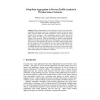Free Online Productivity Tools
i2Speak
i2Symbol
i2OCR
iTex2Img
iWeb2Print
iWeb2Shot
i2Type
iPdf2Split
iPdf2Merge
i2Bopomofo
i2Arabic
i2Style
i2Image
i2PDF
iLatex2Rtf
Sci2ools
DCOSS
2006
Springer
2006
Springer
Using Data Aggregation to Prevent Traffic Analysis in Wireless Sensor Networks
When communication in sensor networks occurs over wireless links, confidential information about the communication patterns between sensor nodes could be leaked even when encryption is used to protect the actual contents of the messages. The communication patterns, which often reveal higher volumes of traffic near the sink, could allow an attacker to identify the vicinity of the sink node. With this information, an attacker could potentially disable the network by destroying the sink. In this paper, we present the decoy sink protocol, which protects the location of the sink in target tracking sensor network applications by forwarding data to a decoy sink for aggregation before the aggregated data is forwarded to the real sink from the decoy sink. Combining indirection and data aggregation in our protocol creates more traffic away from the sink and reduces the amount of traffic near the sink, which makes traffic analysis more difficult for attackers.
Related Content
| Added | 22 Aug 2010 |
| Updated | 22 Aug 2010 |
| Type | Conference |
| Year | 2006 |
| Where | DCOSS |
| Authors | William Conner, Tarek F. Abdelzaher, Klara Nahrstedt |
Comments (0)

